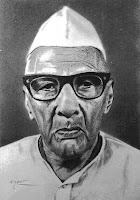River Linking Projects in Odisha ( India )
Orissa will only carry water from Brahmaputra to
Godavari
The December 2004
Tsunami has changed the geographical scenario of many places of Asia including
India. Nature can do anything. Mankind is helpless. But, how far it is
justified to change the map of our country, under the pretext of bringing water
from highly populated areas to the areas where there is scarcity of water? If the river linkage project is implemented,
it is definite that hundreds of villages will be submerged, and it will bring a
change in the map of India.
From 1950 to 1993, 2 crore 16 lakh people were
displaced for various mega projects like big dams, thermal stations, big
industries and sanctuaries in India . Among the affected people 45% are from
Schedule tribes and most of them are from the poorer section. Due to the thirty
proposed River linking projects, how many hundreds of villages will be
submerged in water and how many crores of people will be displaced, it is yet
to be estimated. Detailed Project reports are yet to be prepared. For this man
made Tsunami, map of India may be changed entirely.
In 2001, the Central Government's National
Water Development Agency had estimated 5 lakh 60 thousand Crore rupees as the
cost of these projects. Now the cost may go up to more than 25 lakh Crore rupees.
It has been envisaged to irrigate about 3 crore 50 lakh hectares of cultivable
land and generate 35 thousand megawatt Hydro Electric power.
The objectives of the project are
flood control, drought control, supply of drinking water, fishery, water supply
to industries, and pollution control. If this project is implemented, the
possibility of commercialization of water cannot be ruled out.
In March 2005, the Minister of Water Resources
informed that in the first phase Ken-Betwa project, and in the second phase
Parvati-Kalisindh-Chambal project will be implemented, In the second phase
Madhya Pradesh, Uttar Pradesh and Rajasthan states are involved. In the third
phase, Mahanadi-Godabari project will be implemented. The central minister of
Water Resources said, "The main issue is the consensus amongst the states
involved in these projects". Prior to this, in December 2002, the then
minister of Water Resources of Orissa
said, "A plan is in the process of being worked out to link all the
rivers from Subarnarekha to Rishikulya". It is learnt from the statement
of the minister of Orissa, that the Government of Orissa is prepared to
implement the River linking Plan.
It is learnt from reliable sources that the
following projects may be implemented. The Subarnarekha - Mahanadi project may
be implemented. Then the Ganga - Damodar - Subarnarekha project will be
expanded and will be linked with Subarnrekha - Mahanadi project.
Under the Ganga - Damodar - Subarnarekha project,
Subarnarekha barrage will be built at Bosraghat in West Bengal. In this project
Orissa, Bihar and West Bengal will be involved. About 8 lakh 48 thousand
hectares of land will be irrigated in total, and out of this only 30 thousand
hectares will be irrigated in Orissa. .
As envisaged in the Subarnarekha- Mahanadi
project, water will be carried from Subarnarekha barrage to Manibhadra
reservoir in Orissa. Construction of Manibhadra Dam and about 313 km of
irrigation canals are included in this project. It is likely, more than one
lakh and 75 thousand hectares of land is to be acquired for this. By submerging
one
lakh 75
thousand hectares of land, only four lakh 18 thousand hectares (about two and
half times) will be irrigated through Manibhadra Reservoir. In any project, standard
practice applied should be as follows: Proposed irrigated land should be
atleast 5 to 8 times the land to be submerged. Any deviation to it is not
justified.
Through large dam projects, only partial control
of floods can be achieved. Complete flood control is not possible. If
Manibhadra Dam project is implemented more than one lakh seventy-five thousand hectares of land
will be submerged. As a result, lakhs of people will be displaced. The people
of these affected areas have already rejected this Manibhadra project. If the
name of Manibhadra project is changed to Subalaya, it will also be rejected by
the people. One side of the river is named Manibhadra and the other side Subalaya.
It is said that through the river-linkage
projects pollution will be controlled. But the fact remains that more than 60
thousand hectares of forest land may be submerged. As a result the habitats of
the wild animals will be affected, which will have a great impact on the
surrounding. It is really a ludicrous proposition that there will be pollution
control under these conditions.
The Minister of Water Resources has admitted
that in this project, agreement of the involved parties is most necessary. In the
past, a lot of agreements have been signed on the issue of distribution of
water between different states, but in many cases these agreements have been
violated. The central government gets into embarrassing position for these
disputes. If the issue is not solved at
the political level, some states go to the courts of law for settlement. There
is little hope of the concerned states giving their consent for River-linking
projects. There is scarcity of water in river Mahanadi in any season, other
than rainy reason. In fact, Orissa will
only function as a medium of carrying water from Brahmaputra to Godavari.
Orissa will not be benifitted in any manner. All these project proposals are
now in cold storage. Let it remain so.
,





















































